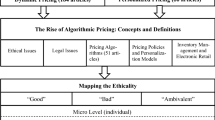Abstract
The theoretical literature suggests that the seller of a unique object maximizes her expected revenue by running a standard auction with an optimally chosen reserve price. However, in reality, there are instances in which sellers decide to accept an offer before the auction starts and cancel the auction. This paper first theoretically investigates the rationale behind this type of behavior and then empirically analyses evidence from real-world auctions. In particular, we suggest that, if some individuals are risk averse—in contrast to the standard auction theory models, in which all parties are risk neutral—then it is possible that accepting a price before the auction maximizes the expected revenue for the seller. Finally, with data on housing market auctions, we show evidence of such behavior and further investigate the implications of the theory.

Similar content being viewed by others
Notes
Standard auctions usually refer to high-bid, English, sealed-bid first, and sealed-bid second-price auctions.
Goeree and Offerman (2004) is one example of residential property auctions.
See Chow et al. (2015) as an example of the comparison between auction and negotiation in the housing market.
In the literature of online auctions, a variety of these options have been studied. Some buyout prices are active until the end of the bidding. Some are only active before the first bidder places a bid. The latter is also called a temporary buyout option.
See also Wang et al. (2008) for an empirical investigation of auctions with buy-it-now option.
Without loss of generality, we normalize the lower bound of the buyers’ valuations to zero. In fact, all results would hold with a positive lower support for the valuation distribution.
Real-world auctions for the relevant markets are usually traditional English auctions, but in this particular setting these two auctions are strategically equivalent; therefore, we have chosen the second-price auction for the sake of convenience.
There are many reasons that a seller may prefer not to disclose a reserve price. For instance, see (Rosenkranz and Schmitz 2007) and (Li and Tan 2000) for two possible explanations. However, our analysis is not sensitive to the disclosure of a reserve price, and the results hold with a disclosed reserve price.
(Krishna 2002).
It is possible in real world situations to have a case in which both the seller and buyers are risk-averse. To address this issue we consider the comparison of the risk level of each party. For instance, if the seller is more risk-averse than buyers, then the result would be similar to a case with risk-neutral buyers and a risk-averse seller.
The data for the current paper is collected by the Australian Property Monitors (APM). The sources of this data are mainly the government and real estate agents.
In the Australian housing market, there is another major selling method beside auctions, that is, private negotiation. Since properties which were advertised via auction usually have unique characteristics and features compared to those which were sold via private negotiation, we assume it is not possible to have two identical properties where one was sold via auction and the other via private negotiation. However, it is possible to have two identical properties advertised for selling via auction, where one ends up with a settlement before the auction and the other sells under the hammer.
The terms “apartment” and “unit” have a similar meaning and refer to the same category.
Quartile dummies are based on the quartile in which the transaction price of the properties lies. Specifically, quartile one includes properties with transaction prices lower than 540,000 Australian Dollar (AUD). Quartile two indicates properties with transaction prices higher than 540,000 AUD and less than 749,000 AUD. Quartile three includes properties with prices between 750,000 AUD and 1,000,000 AUD. Quartile four includes properties with transaction prices above 1 million dollars.
We also ran these models with dummies that specified the quarter in which the auction took place but found no significant difference versus the current results.
The r-square for the hedonic regression is 0.87.
References
Ashenfelter, O.C. (1989). How auctions work for wine and art. Journal of Economic Perspectives, 3(3), 23–36.
Chow, Y.L., Hafalir, I.E., & Yavas, A. (2015). Auction versus negotiated sale: Evidence from real estate sales. Real Estate Economics, 43(2), 432–470.
Goeree, J. K., & Offerman, T. (2004). The Amsterdam auction. Econometrica, 72(1), 281–294.
Heckman, J.J. (1979). Sample selection bias as a specification error. Econometrica, 47(1), 153–161.
Kirkegaard, R., & Overgaard, P.B. (2008). Buy-out prices in auctions: Seller competition and multi-unit demands. The RAND Journal of Economics, 39(3), 770–789.
Krishna, V. (2002). Auction theory. San Diego: Academic Press.
Li, H., & Tan, G. (2000). Hidden reserve prices with risk averse bidders. Working paper, University of British Columbia.
Maskin, E., & Riley, J. (1984). Optimal auctions with risk averse buyers. Econometrica, 52(6), 1473–1518.
Mathews, T. (2004). The impact of discounting on an auction with a buyout option: a theoretical analysis motivated by ebay’s buy-it-now feature. Journal of Economics, 81(1), 25–52.
Mathews, T., & Katzman, B. (2006). The role of varying risk attitudes in an auction with a buyout option. Economic Theory, 27(3), 597–613.
Myerson, R.B. (1981). Optimal auction design. Mathematics of Operations Research, 6, 58–73.
Reynolds, S.S., & Wooders, J. (2009). Auctions with a buy price. Economic Theory, 38(1), 9–39.
Rosenkranz, S., & Schmitz, P.W. (2007). Reserve prices in auctions as reference points. Economic Journal, 117(520), 637–653.
Wang, X., Montgomery, A., & Srinivasan, K. (2008). When auction meets fixed price: a theoretical and empirical examination of buy-it-now auctions. Quantitative Marketing and Economics, 6(4), 339–370.
Author information
Authors and Affiliations
Corresponding author
Rights and permissions
About this article
Cite this article
Khezr, P. Why Sellers Avoid Auctions: Theory and Evidence. J Real Estate Finan Econ 56, 163–182 (2018). https://doi.org/10.1007/s11146-016-9594-8
Published:
Issue Date:
DOI: https://doi.org/10.1007/s11146-016-9594-8




